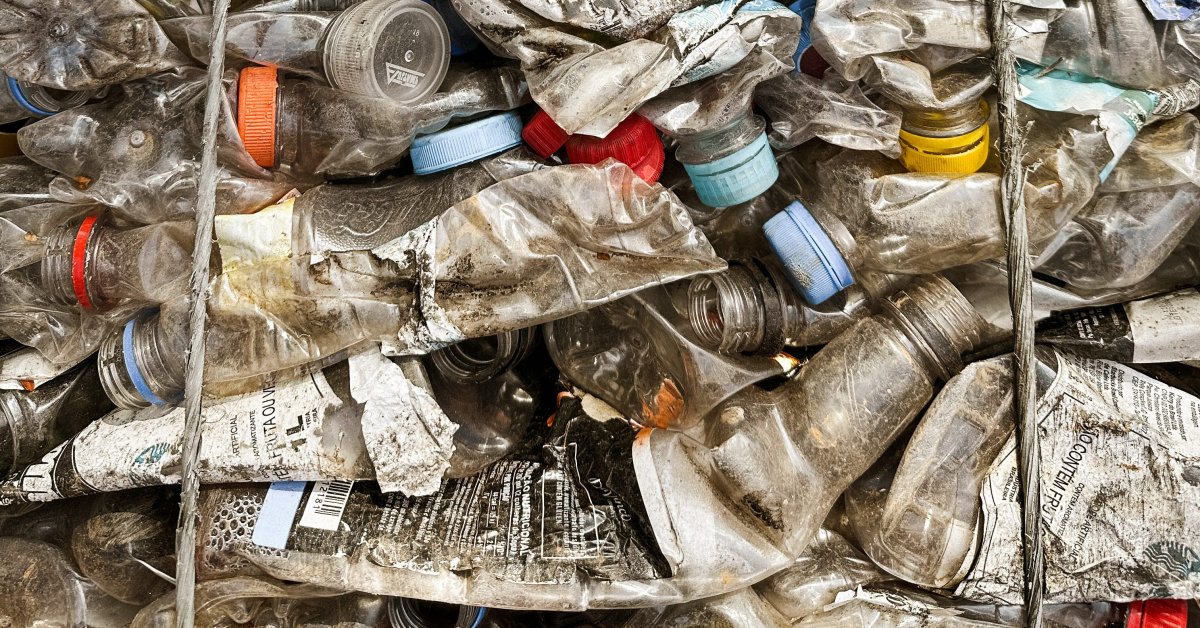In the searing heat at the ACAMTC recycling cooperative south of São Paulo, in Três Corações, Brazil, a group of recycling waste workers known as Catadores prepared bales of discarded plastic for transport. As the group of mostly women worked, they spoke humbly of how important their work is to helping make the planet a cleaner place. “I feel a mix of admiration and sadness,” said Evelini Castro Rocha, financial director of the Rede Sul e Sudoeste de Minas Gerais network of cooperatives. “The work of the Catadores is essential for the health of the environment, and I am very happy to be a part of it.” But, she worries they don’t get enough recognition for their work.
The inconvenient truth is that all the shoes we’ve ever owned and discarded are likely still sitting in a landfill. Over 24 billion pairs of shoes are produced globally each year, and in the U.S. alone, an estimated 300 million pairs are thrown away annually. With fast-fashion rampant, and marketing focused on novelty, designed to drive up consumption, people are buying more, but keeping items for half as long. Footwear is no exception, with consumers amassing sizable shoe collections with an equally sizable carbon footprint.
The fashion and textile industry has a reliance on petroleum-based materials, considered indispensable for their durability and versatility. Polyester, for example, now dominates as the most widely used fiber with 71 million tons produced in 2023, accounting for 57% of global fiber production. From nylon to acrylic, these synthetic materials have a concerning climate cost: the fossil fuels associated with textile production are contributing to the industry’s hefty climate footprint, with environmental impacts across the value chain, including water use, energy consumption, the release of microplastics, and over 92 million tons of textile waste produced per year. This non-biodegradable textile waste ends up in landfills where it can take hundreds of years to break down, releasing greenhouse gasses and leaching toxic chemicals into groundwater and soil.
But an increasing number of brands are swapping out synthetic fibers for lower-impact recycled alternatives—like polyester made predominantly from polyethylene terephthalate (PET) plastic bottles—in a bid to minimize their environmental impact. The challenge, however, is that they are still synthetic materials at the end of the day, with many of the same impacts as their virgin counterparts. However, a supply chain focused on upcycling, complemented by initiatives designed to keep such materials from ending up as waste, can help mitigate some of these impacts.
Gerais at the ACAMTC cooperative, Três Corações, Brazil.Veja
Sustainable footwear brand Veja has been using recycled PET polyester since 2015, but the company couldn’t trace exactly where the bottles came from. This lack of visibility didn’t align with its commitment to transparency, so over the last two years, Veja has been leading the way in changing this.
In 2023, the brand teamed up with the Catadores network of recycling waste workers in the State of Minas Gerais in Southeastern Brazil. Together, they co-created a fully traceable, 100% post-consumer recycled polyester supply chain. From the plastic bottle that once littered the street to the fabric that lines its shoes, Veja is showing how to create a more transparent and sustainable supply chain.
Brazil is one of the world’s most progressive countries when it comes to integrating waste pickers into its solid waste management systems. The Minas Gerais Catadores are part of a network of around 200 people—60% of which are women—making up 13 cooperatives across the region. According to Veja, these cooperatives play a crucial role in recycling in Brazil, handling approximately 90% of recycled materials.
Using plastic bottles exclusively from this network, last year, Veja purchased 6 million PET bottles from the cooperatives for its shoes. Through a contract guided by fair trade principles, social and economic justice, and minimal environmental impact, the newly stood up supply chain provides Veja with full visibility into where the bottles come from. The project is a small step with a big impact, helping Veja produce a more sustainable shoe, while supporting the income of the Catadores. “The Brazilian Catadores play a vital role in our PET supply chain, because without them we wouldn’t have a supply chain with a level of transparency that we can feel good about,” says Veja co-founder François-Ghislain Morillion. Veja pays a bonus of $1.20 in addition to market price (which ranges from $0.52 to $0.69) for every 2.2 pounds (1kg) of clear plastic bottles.
In doing so, Veja is helping to improve the livelihood of those who work in the cooperatives, with the Catadores earning three to four times more than standard market price; the 6 million bottles purchased in 2023 from the cooperatives represented a combined bonus for the network of $160,000.
Maria Rosa, a mother of four who works at the Atremar recycling cooperative in Três Pontas, considers the contract with Veja a blessing that helps provide more financial stability for her and her family, while offering recognition of her line of work. And as Castro Rocha explained: “Sadly, our work is still very undervalued by our society, because of the lack of education about its importance and the historic lack of appreciation of professions linked to recycling and environmental conservation.”
“Through our supply chain, we are trying to address some of the inequalities that exist in Brazil by creating a social movement,” says Morillion, “because at the center of it all, it’s people that carry these projects on their shoulders.”

Once the bales of bottles leave the cooperative, they make their way to a plastic manufacturing factory where they are washed and ground into flakes before being processed into small pellets. Bales inevitably include a small percentage of contaminants (non-PET, green and blue plastic, bottle caps and rings) that must be separated to ensure purity of only clear PET, seen as highest value and preferred for its wider use of applications. Liquid waste generated from the process goes through water treatment so it can be reused. An extruder then melts the plastic to produce the final pellets.
Next comes the creation of the textile itself, a process that starts with dyeing the plastic pellets using a waterless “dope dyeing” method, and spinning them at 3,000 revolutions per minute into a flexible yarn that gets spooled and ready for weaving. Every pound of the final 100% post-consumer recycled fabric, known as Eleva, uses around 100 bottles and saves over 10 gallons of water, according to Dini Têxtil, a textile manufacturing company. The fabric then finds its way into Veja shoes as the lining material across its range of styles.
While seeing more recycled materials such as recycled polyester (rPET) turning up in apparel may seem like an easy environmental win, experts caution consumers may believe this new generation of materials is more of a magic bullet than they actually are.
When it comes to brands claiming that they are diverting plastic bottles from landfill, there’s an important distinction to be made, according to Maxine Bédat, director at New Standards Institute, and author of Unraveled: The Life and Death of a Garment. “It is the consumer of the beverage who chooses to divert the plastic bottle from the landfill by placing the empty bottle in the recycling bin instead of the trash,” says Bédat. If a company buys regular rPET, and has not been involved with additional collection, it’s misleading to claim that specific company is responsible for diverting plastic bottles from landfill, according to Bédat, as it has simply benefited from consumers doing so. For Veja, working closely with the Catadores and the recycling cooperatives allows the company a line of sight into the origins of the plastic bottles, and confirmation that they are post-consumer.
There are also questions around whether using rPET for clothing simply ends up creating more waste. “While some of this apparel may in fact be diverting bottles from landfill, we know that a plastic bottle that becomes a piece of clothing can’t readily be recycled and is unlikely to be turned into something else, but a bottle can be turned into another bottle in the recycling stream,” notes Bédat. With the advent of fast fashion—which is notoriously hastily discarded after minimal use—turning recovered plastic bottles into apparel may in fact expedite their journey to the landfill, according to Bédat. “In its approach to swapping out synthetic materials in favor of recycled substitutes made from plastic bottles, the textile industry is taking an item from an established circular recycling stream and moving it to one that is linear,” she says.
When it comes to climate impact in apparel, the fiber actually matters a lot less than how that fiber is processed into fabric, according to Bédat, referring to factory manufacturing that is known to be energy-intensive and account for a high proportion of a garment’s lifecycle emissions. “If we are trying to address climate impacts,” notes Bédat, “boasting lower emissions associated with recycled fibers, while ignoring the much more carbon-intensive processing, leads us down a path that is overly focused on circularity at the expense of decarbonizing the actual hotspot of emissions: the textile factories.”
Believing the only way to address blind spots is to measure everything, Veja digs deep into its emissions, with a particular focus on scope 3 involving all of the activities carried out by its suppliers and partners, from raw materials to transportation. By knowing exactly where its materials come from and seeing production first-hand, Veja is able to monitor its environmental impact in areas such as water and energy consumption, fair and safe working conditions in factories, and eliminating the need for any overseas shipping by producing materials locally where its shoes are made.

“I worry that the fashion sector sees the circular economy—which includes the use of rPET—as a get-out-of-jail-free card,” says Monica Buchan-Ng, head of knowledge exchange (sustainability) at the Centre for Sustainable Fashion, University of the Arts London, “allowing brands to keep making more ‘sustainable’ apparel because it’s made of waste, without addressing the core of the problem which is overproduction and overconsumption.”
“Scaling a circular economy for fashion relies on textile-to-textile recycling to ensure waste stays in the technical cycle,” says Buchan-Ng. The problem is, limitations of textile-to-textile recycling—estimated to account for a mere 2% of all recycled polyester—are hampering progress towards the industry’s environmental goals. When it comes to footwear, a shoe’s synthetic components that are molded, stitched, and glued makes recycling them near impossible. But what if instead of throwing shoes away, we could extend their life?
Believing that the most sustainable shoes are the ones you already own, Veja is committed to helping consumers keep their shoes in use longer, by offering a modern revival of the old-world trade of shoe repair. In 2020, Veja launched its “Clean, Repair, and Collect” project with the opening of its first cobbler station in Bordeaux, France, Now, with eight cobblers in cities including Berlin, Madrid, and New York, Veja has repaired roughly 30,000 pairs of sneakers.
“There is a need for brands to encourage prolonged use of products,” says Buchan-Ng. “Instead of campaigns designed to drive consumption, brands should design them to help their consumers have a more fulfilling relationship with their apparel, to care for and keep them longer.” For Veja, it’s about striking a balance between sustainability and durability, because it’s not sustainable if the shoes don’t last.
Meanwhile in Brazil, at the Ação Reciclar cooperative in Poços de Caldas, two staffers beamed with awe as they opened shoe boxes revealing their new pairs of Veja sneakers, made with the recycled polyester they helped bring to life.




